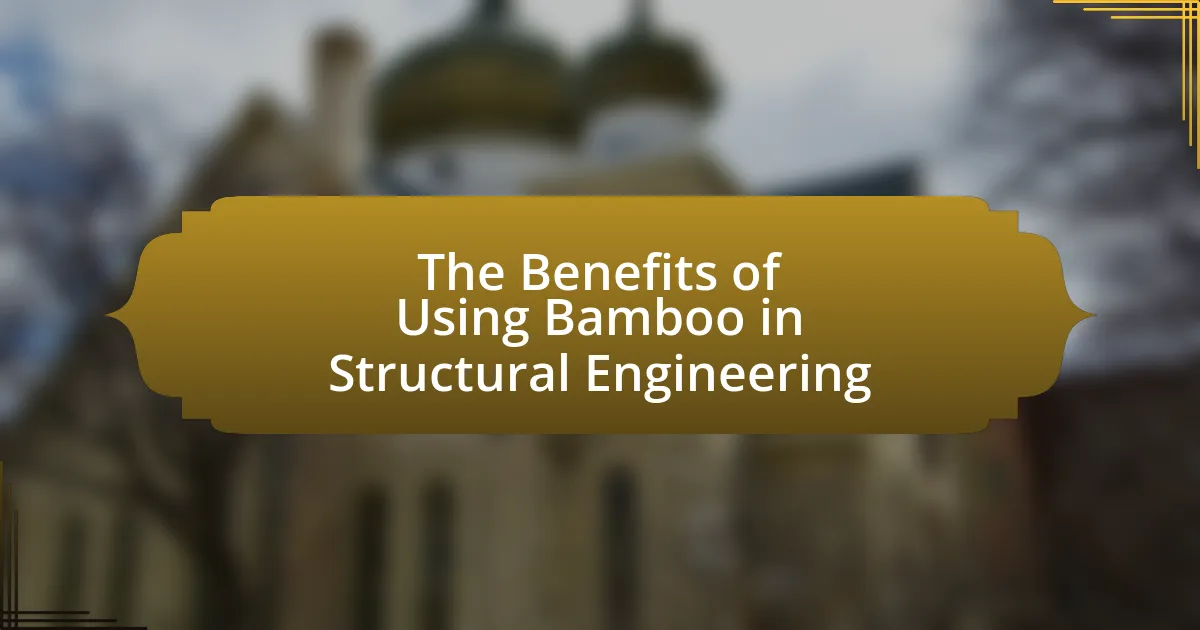Bamboo is increasingly recognized as a valuable material in structural engineering due to its high strength-to-weight ratio, rapid growth, and sustainability. This article explores the numerous benefits of using bamboo, including its mechanical properties that rival traditional materials like steel and concrete, its eco-friendly characteristics, and its potential for reducing construction costs. Additionally, it addresses the challenges associated with bamboo, such as susceptibility to pests and variability in material properties, while highlighting advancements in treatment and design that enhance its viability. The future prospects of bamboo in sustainable architecture and its role in meeting global sustainability goals are also examined, showcasing its potential in various construction markets.

What are the Benefits of Using Bamboo in Structural Engineering?
Bamboo offers numerous benefits in structural engineering, primarily due to its high strength-to-weight ratio, sustainability, and flexibility. Its tensile strength is comparable to steel, making it an excellent material for load-bearing structures. Additionally, bamboo grows rapidly, reaching maturity in three to five years, which contributes to its sustainability as a renewable resource. The natural flexibility of bamboo allows it to withstand seismic forces better than traditional materials, enhancing the resilience of structures in earthquake-prone areas. Furthermore, using bamboo can reduce carbon footprints, as it sequesters carbon dioxide during its growth, contributing to environmental sustainability in construction practices.
How does bamboo compare to traditional building materials?
Bamboo is often considered superior to traditional building materials like wood, steel, and concrete due to its high strength-to-weight ratio, rapid growth, and sustainability. Specifically, bamboo can withstand tensile forces better than steel and has a compressive strength comparable to concrete, making it an excellent structural material. Additionally, bamboo grows significantly faster than traditional timber, reaching maturity in three to five years, while hardwood trees can take decades. This rapid growth contributes to its sustainability, as bamboo can be harvested without damaging the ecosystem. Furthermore, studies have shown that bamboo’s carbon sequestration capabilities are higher than those of many conventional materials, enhancing its environmental benefits.
What are the mechanical properties of bamboo that make it suitable for construction?
Bamboo possesses exceptional mechanical properties that make it highly suitable for construction, including high tensile strength, compressive strength, and flexibility. The tensile strength of bamboo can reach up to 100 MPa, which is comparable to steel, allowing it to withstand significant pulling forces without breaking. Its compressive strength ranges from 30 to 50 MPa, enabling it to support heavy loads effectively. Additionally, bamboo’s natural flexibility allows it to absorb shocks and resist bending, making it ideal for earthquake-prone areas. These properties are attributed to its unique cellular structure, which consists of strong fibers and a lightweight composition, providing both strength and durability.
How does bamboo’s strength-to-weight ratio benefit structural designs?
Bamboo’s strength-to-weight ratio significantly benefits structural designs by providing high tensile strength while remaining lightweight. This unique property allows for the construction of resilient structures that require less material, reducing overall weight and material costs. For instance, bamboo can withstand tensile forces comparable to steel, making it an effective alternative in various applications, including beams and trusses. Additionally, its lightweight nature facilitates easier handling and transportation, which can lead to faster construction times and lower labor costs.
Why is bamboo considered an eco-friendly option in construction?
Bamboo is considered an eco-friendly option in construction due to its rapid growth rate and renewability. It can grow up to 91 centimeters in a single day and reaches maturity in three to five years, making it a sustainable alternative to traditional timber, which can take decades to mature. Additionally, bamboo absorbs carbon dioxide and releases oxygen at a higher rate than many trees, contributing positively to the environment. Its cultivation requires minimal pesticides and fertilizers, further reducing its ecological footprint. Studies have shown that bamboo can sequester significant amounts of carbon, with estimates suggesting it can absorb up to 35% more CO2 than equivalent hardwoods.
What are the environmental impacts of using bamboo versus conventional materials?
Using bamboo has significantly lower environmental impacts compared to conventional materials like steel and concrete. Bamboo grows rapidly, reaching maturity in three to five years, while conventional materials often require decades to produce and involve energy-intensive processes. For instance, the production of concrete emits approximately 0.9 tons of CO2 per ton produced, whereas bamboo sequesters carbon during its growth, contributing positively to carbon reduction efforts. Additionally, bamboo cultivation requires less water and no pesticides, promoting biodiversity and reducing soil erosion, unlike conventional materials that can lead to habitat destruction and increased pollution. These factors collectively highlight bamboo’s advantages in minimizing environmental harm compared to traditional construction materials.
How does bamboo cultivation contribute to sustainability?
Bamboo cultivation contributes to sustainability by sequestering carbon dioxide, improving soil health, and providing renewable resources. Bamboo can absorb up to 12 tons of carbon dioxide per hectare annually, significantly mitigating greenhouse gas emissions. Additionally, its extensive root system prevents soil erosion and enhances soil fertility, promoting biodiversity. Bamboo grows rapidly, reaching maturity in three to five years, making it a highly renewable resource for construction and other applications, reducing reliance on slower-growing timber species.
What economic advantages does bamboo offer in structural engineering?
Bamboo offers significant economic advantages in structural engineering due to its rapid growth, low material costs, and high strength-to-weight ratio. Bamboo can grow up to 91 cm in a single day, allowing for a sustainable supply that reduces long-term material costs compared to traditional timber and steel. Additionally, its tensile strength is comparable to that of steel, making it an efficient choice for construction that minimizes the need for additional structural support, thereby lowering overall project expenses. Studies have shown that using bamboo can reduce construction costs by up to 30% in certain applications, highlighting its potential as a cost-effective alternative in the building industry.
How does the cost of bamboo compare to other materials in construction projects?
Bamboo is generally more cost-effective than traditional construction materials like steel and concrete. The price of bamboo can range from $2 to $5 per linear foot, while steel typically costs around $6 to $10 per linear foot and concrete averages $100 per cubic yard. Additionally, bamboo’s rapid growth and renewability contribute to lower long-term costs, as it can be harvested in three to five years compared to decades for hardwoods. This economic advantage is supported by studies indicating that bamboo can reduce overall construction costs by up to 30% when used in appropriate applications.
What are the long-term savings associated with using bamboo in structures?
Using bamboo in structures can lead to significant long-term savings primarily due to its rapid growth, low material costs, and durability. Bamboo can grow up to 91 cm in a single day, allowing for a sustainable supply that reduces procurement costs over time. Additionally, bamboo’s strength-to-weight ratio is comparable to steel, which can lower construction costs by reducing the amount of material needed for structural integrity. Research indicates that buildings made from bamboo can have lower maintenance costs due to its natural resistance to pests and decay, further contributing to long-term savings. For instance, a study published in the Journal of Cleaner Production highlights that bamboo structures can reduce overall lifecycle costs by up to 30% compared to traditional materials.

What are the Challenges of Using Bamboo in Structural Engineering?
The challenges of using bamboo in structural engineering include variability in material properties, susceptibility to pests and decay, and difficulties in standardization and design codes. Bamboo’s mechanical properties can vary significantly based on species, growth conditions, and treatment methods, making it challenging to predict performance in structural applications. Additionally, bamboo is prone to insect infestations and fungal decay, which can compromise its durability if not properly treated. Furthermore, the lack of established design codes and standards for bamboo construction limits its widespread adoption in engineering practices, as engineers often rely on standardized materials with well-documented performance metrics.
What are the limitations of bamboo as a building material?
Bamboo has several limitations as a building material, primarily its susceptibility to pests and moisture. This vulnerability can lead to structural degradation if not properly treated. Additionally, bamboo’s mechanical properties can vary significantly based on species and growing conditions, which may affect its reliability in construction. Furthermore, bamboo lacks standardized grading systems, making it challenging to assess its quality consistently. Lastly, its fire resistance is lower compared to traditional materials, posing safety concerns in certain applications.
How does bamboo’s susceptibility to pests affect its use in construction?
Bamboo’s susceptibility to pests limits its use in construction due to potential structural damage and increased maintenance costs. This vulnerability can lead to infestations that compromise the integrity of bamboo structures, making them less reliable compared to traditional materials. For instance, studies have shown that untreated bamboo can be prone to attacks from termites and fungi, which can significantly reduce its lifespan and durability. Consequently, builders often need to apply protective treatments or select specific bamboo species that are more resistant to pests, which can complicate the construction process and increase overall project expenses.
What are the challenges in sourcing and processing bamboo for structural use?
The challenges in sourcing and processing bamboo for structural use include variability in quality, limited supply chains, and the need for specialized treatment processes. Variability in quality arises because bamboo species differ significantly in strength and durability, impacting its suitability for structural applications. Limited supply chains can hinder access to high-quality bamboo, as many regions lack established networks for sustainable harvesting and distribution. Additionally, bamboo requires specific treatment to prevent pests and decay, which can complicate processing and increase costs. These factors collectively pose significant obstacles to the effective use of bamboo in structural engineering.
How can the challenges of using bamboo be mitigated?
The challenges of using bamboo can be mitigated through proper treatment and design techniques. Treatment methods such as chemical preservation can enhance bamboo’s durability against pests and environmental factors, significantly increasing its lifespan. Additionally, employing engineering design principles, such as ensuring adequate load distribution and using appropriate joinery techniques, can address structural weaknesses. Research indicates that treated bamboo can achieve comparable strength to traditional materials, making it a viable alternative in construction. For instance, studies have shown that bamboo treated with boron compounds can resist fungal decay and insect attacks, thus improving its performance in structural applications.
What treatments can enhance the durability of bamboo in construction?
Chemical treatments such as boron and copper-based preservatives can significantly enhance the durability of bamboo in construction. These treatments protect bamboo from pests, fungi, and moisture, which are common threats to its structural integrity. For instance, boron compounds have been shown to effectively prevent decay and insect damage, while copper-based preservatives provide long-lasting protection against biological deterioration. Studies indicate that treated bamboo can last significantly longer than untreated bamboo, with some treatments extending its lifespan to over 20 years in outdoor conditions.
How can design innovations address the limitations of bamboo?
Design innovations can address the limitations of bamboo by enhancing its structural integrity and durability through advanced engineering techniques. For instance, the application of composite materials can significantly improve bamboo’s tensile strength and resistance to environmental factors, such as moisture and pests. Research conducted by the International Network for Bamboo and Rattan (INBAR) indicates that combining bamboo with synthetic resins can create hybrid materials that outperform traditional bamboo in load-bearing applications. Additionally, innovative design approaches, such as modular construction and optimized joint systems, can maximize bamboo’s natural properties while minimizing its susceptibility to failure under stress. These advancements not only extend the lifespan of bamboo structures but also broaden its applicability in modern architectural designs.

What are the Future Prospects of Bamboo in Structural Engineering?
The future prospects of bamboo in structural engineering are promising due to its high strength-to-weight ratio, sustainability, and rapid growth rate. Bamboo has been shown to possess comparable mechanical properties to traditional construction materials like steel and concrete, making it a viable alternative for various structural applications. Research indicates that bamboo can withstand significant tensile and compressive forces, which supports its use in load-bearing structures. Additionally, bamboo’s renewability and lower carbon footprint align with global sustainability goals, further enhancing its appeal in modern construction practices. Studies, such as those published in the Journal of Cleaner Production, highlight bamboo’s potential to reduce environmental impact while providing durable and resilient building solutions.
How is technology influencing the use of bamboo in construction?
Technology is significantly enhancing the use of bamboo in construction by improving its structural properties and facilitating its integration into modern building practices. Advanced treatment methods, such as chemical preservation and heat treatment, increase bamboo’s durability and resistance to pests and moisture, making it a viable alternative to traditional materials. Additionally, innovations in design software and engineering techniques allow for optimized structural designs that leverage bamboo’s unique tensile strength, which is comparable to steel. Research conducted by the International Network for Bamboo and Rattan highlights that engineered bamboo products, such as laminated bamboo beams, can achieve higher load-bearing capacities, thus expanding their application in various construction projects.
What advancements in engineering are making bamboo a more viable option?
Advancements in engineering, such as improved treatment methods, enhanced design techniques, and innovative composite materials, are making bamboo a more viable option for construction. Enhanced treatment methods, including boron and heat treatment, increase bamboo’s durability and resistance to pests and moisture, addressing its natural vulnerabilities. Additionally, modern design techniques, like the use of software for structural analysis, allow engineers to optimize bamboo’s unique properties, ensuring safety and efficiency in construction. Furthermore, the development of bamboo composites, which combine bamboo fibers with other materials, enhances strength and versatility, making bamboo suitable for a wider range of applications. These advancements collectively support bamboo’s growing acceptance in structural engineering, backed by studies demonstrating its comparable strength-to-weight ratio to traditional materials like steel and concrete.
How are architects and engineers innovating with bamboo in modern designs?
Architects and engineers are innovating with bamboo in modern designs by utilizing its high strength-to-weight ratio and sustainability as a primary material for structural elements. This innovation includes the development of prefabricated bamboo components that can be easily assembled on-site, reducing construction time and waste. For instance, projects like the Green School in Bali showcase bamboo’s versatility in creating eco-friendly, aesthetically pleasing structures that blend with the environment. Additionally, research from the International Network for Bamboo and Rattan highlights bamboo’s potential to replace traditional materials in construction, emphasizing its rapid growth and renewability, which aligns with global sustainability goals.
What role does bamboo play in the future of sustainable architecture?
Bamboo plays a crucial role in the future of sustainable architecture due to its rapid growth, high strength-to-weight ratio, and carbon sequestration capabilities. As a renewable resource, bamboo can grow up to 91 centimeters in a single day, making it one of the fastest-growing plants on Earth. This rapid growth allows for sustainable harvesting practices that do not deplete resources. Additionally, bamboo’s tensile strength is comparable to that of steel, enabling it to be used in various structural applications while reducing the need for more energy-intensive materials. Furthermore, bamboo absorbs significant amounts of carbon dioxide during its growth, contributing to lower greenhouse gas emissions in construction. These attributes position bamboo as a viable alternative in sustainable architecture, promoting eco-friendly building practices and reducing the overall environmental impact of construction.
How can bamboo contribute to meeting global sustainability goals?
Bamboo can significantly contribute to meeting global sustainability goals by serving as a renewable resource that sequesters carbon, reduces deforestation, and promotes biodiversity. As a fast-growing plant, bamboo can reach maturity in three to five years, allowing for sustainable harvesting without long-term environmental impact. Studies indicate that bamboo can absorb up to 12 tons of carbon dioxide per hectare annually, making it an effective tool for climate change mitigation. Additionally, bamboo cultivation can restore degraded lands, enhance soil quality, and provide habitat for various species, thus supporting ecosystem health.
What are the potential markets for bamboo in structural engineering?
The potential markets for bamboo in structural engineering include residential construction, commercial buildings, and infrastructure projects. Bamboo’s high strength-to-weight ratio and rapid growth make it an attractive alternative to traditional materials like steel and concrete. In residential construction, bamboo can be used for framing, flooring, and roofing, offering sustainable options for eco-friendly homes. In commercial buildings, its aesthetic appeal and durability can enhance design while reducing carbon footprints. Infrastructure projects, such as bridges and public facilities, can benefit from bamboo’s resilience and cost-effectiveness, as demonstrated by successful implementations in countries like India and Colombia, where bamboo has been utilized in various structural applications.
What are the best practices for using bamboo in structural engineering?
The best practices for using bamboo in structural engineering include selecting appropriate species, ensuring proper treatment, and adhering to design standards. Specific bamboo species, such as Guadua angustifolia and Bambusa vulgaris, are preferred for their strength and durability. Proper treatment methods, such as boron treatment or heat treatment, are essential to enhance resistance to pests and decay. Additionally, structural designs should comply with established codes, such as the International Building Code, which provides guidelines for load-bearing capacities and safety. Research indicates that bamboo can achieve compressive strengths comparable to concrete, making it a viable alternative in sustainable construction.

Leave a Reply